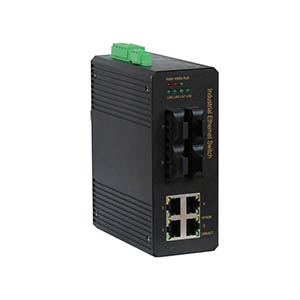Managed vs Unmanaged Industrial Switch: What are Their Difference?
The industrial Ethernet has been wildly used in daily life. As an important component of the network, industrial switches play an important role in current industrial automation. Industrial field switches can be divided into two categories: unmanaged and managed. General device internal network, such as CPU. Unmanaged switches are used for data exchange between distributed modules; managed switches are used for communication between devices and the factory network. They all belong to the industrial ethernet switches. So, what is the difference between an unmanaged switch and a managed switch? Today we will talk about this topic.
Unmanaged switch
An unmanaged switch, is a network switching device that works at the second layer (data link layer) of the OSI network reference model. The data forwarding of the unmanaged switch is based on the MAC address. It can identify the MAC address in the data packet and send the data to the corresponding port according to the MAC address table stored inside it (initial state. When the MAC address table is empty at that time, the switch will broadcast the data to all ports.
With the sending and receiving of data, the relationship between the MAC address and the port is gradually established and updated in time according to the actual situation). Unmanaged switches are plug-and-play devices that do not support routing management; cannot divide VLANs; because they do not recognize IP headers, all nodes can only be divided into the same subnet. The unmanaged switch is relatively cheap and easy to use. It is suitable for the internal network of the device, such as the data exchange of each network node of PROFINET.
Managed switch
Managed switches are also called network managed switches, which are relative to unmanaged switches. Managed switches work on the third layer (network layer) of the OSI network reference model, supporting VLAN division, routing functions, SNMP protocol (simple network management protocol), and can be configured through the web.
The ability to divide VLANs is one of the characteristics of managed switches. VLAN is the abbreviation of "Virtual Local Area Network" in English. By dividing VLANs, the LAN connected to the switch can be logically divided into different subnets (Subnets), and the subnets cannot communicate directly, thereby effectively isolating network storms and enhancing network security.
VLAN also increases the flexibility of network management. It only needs to configure the software to change the network to which the device belongs, without changing the physical connection. Supporting router functions is another feature of managed switches. The routing function can analyze the IP address in the message, and forward the data according to the routing table inside the switch, which can realize the data exchange between different subnets. Compared with unmanaged switches, managed switches provide more functions and are more expensive.
Key differences between managed and unmanaged switches
Obviously, the main difference between managed switches and unmanaged switches is their management methods. For managed switches, network administrators can more flexibly control, manage, and prioritize LAN traffic. However, an unmanaged switch works more like a plug-and-play switch, enabling mutual communication between LANs without user intervention.
The following points will help you better understand other key points of difference between managed and unmanaged switches:
Freedom to configure
A managed switch is a device that allows users to manage, configure and monitor a LAN. They allow users to create new LANs and isolate smaller devices and help users manage traffic efficiently. Managed network switches have advanced features such as allowing users to recover data and allowing data recovery in the event of equipment or network failure. Unmanaged switches may be easy to use, but they have a fixed configuration, which means you cannot change the network. That's why it's most often used in startups with limited data exchange.
Performance management
Unmanaged switches are plug-and-play switches. They have built-in QOS services, ensuring they are easy to set up and practical. However, managed switches allow you to manage performance through prioritized channels. It utilizes protocols such as Simple Network Management Protocol (SNMP) to monitor the performance of all devices connected to the LAN on the Ethernet.
Managed switches also use SNMP to analyze the current performance of devices on the network through an easy-to-understand graphical interface. Additionally, SNMP enables remote management of connected devices and networks without physical intervention on the switch
Security function
Unmanaged switches have basic security features, such as the ability to close ports, to ensure basic security and help prevent any form of direct tampering with the device. However, managed switches have advanced features that help identify active threats and shut them down promptly, protecting data and control.
Cost
Unmanaged switches are cheap and easy to accept, while managed switches are more expensive due to more functions. Through such a comparison, the managed switch is still superior in technology, but the size is short and the size is strong. The managed switch is powerful, powerful, and stable, and is suitable for large-scale network environments; as for the non-managed switch, that is Plug and play, easy to manage, and relatively cheap. It is widely used in the establishment of small networks.


